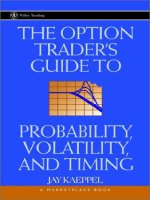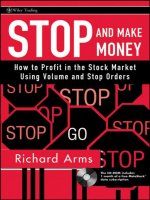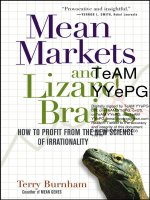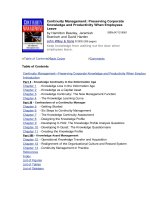John wiley sons mean markets and lizard brains how to profit (2005) yyepg lotb
Bạn đang xem bản rút gọn của tài liệu. Xem và tải ngay bản đầy đủ của tài liệu tại đây (2.11 MB, 322 trang )
Praise for
Mean Markets
“Conventional finance axioms—no-frills rationality and maximizing
happy campers—are found wanting. In his wonderful Mean Markets
and Lizard Brains, Terry Burnham shows you why. Comingling biology
and finance has never been so entertaining.”
—Jamil Baz, Head of Global Rates Research,
Deutsche Bank
“A fascinating application of evolutionary theory that revolutionizes our
understanding of how financial markets behave. I have already altered
my own portfolio allocation after reading this book. If you read it, I am
sure you will too.”
—Nitin Nohria, Richard P. Chapman
Professor, Harvard Business School
and coauthor of
Driven: How Human Nature
Shapes Our Choices
“Mean Markets and Lizard Brains should be required reading for every
Wall Street professional whether in sales, trading, research, or corporate
finance. It reveals that individuals often act irrationally for a very rational reason; they have inherited a thought process that goes way back to
the days of hunter-gatherers so that brains are built to be out of sync
with rational financial decision making. Understanding this profound
message should allow investors to improve performance and make
fewer mistakes. This is a fascinating book that is certain to become a
must read for every investor in the financial markets.”
—Sadek Wahba, Managing Director,
Morgan Stanley
Mean
Markets
and
Lizard
Brains
HOW TO PROFIT FROM THE NEW
SCIENCE OF IRRATIONALITY
Terry Burnham
John Wiley & Sons, Inc.
Copyright © 2005 by Terry Burnham. All rights reserved.
Published by John Wiley & Sons, Inc., Hoboken, New Jersey
Published simultaneously in Canada
No part of this publication may be reproduced, stored in a retrieval system, or transmitted
in any form or by any means, electronic, mechanical, photocopying, recording, scanning,
or otherwise, except as permitted under Section 107 or 108 of the 1976 United States
Copyright Act, without either the prior written permission of the Publisher, or authorization through payment of the appropriate per-copy fee to the Copyright Clearance Center,
222 Rosewood Drive, Danvers, MA 01923, 978-750-8400, fax 978-646-8600, or on the
web at www.copyright.com. Requests to the Publisher for permission should be
addressed to the Permissions Department, John Wiley & Sons, Inc., 111 River Street,
Hoboken, NJ 07030, 201-748-6011, fax 201-748-6008.
Limit of Liability/Disclaimer of Warranty: While the publisher and the author have used
their best efforts in preparing this book, they make no representations or warranties with
respect to the accuracy or completeness of the contents of this book and specifically disclaim any implied warranties of merchantability or fitness for a particular purpose. No
warranty may be created or extended by sales representatives or written sales materials.
The advice and strategies contained herein may not be suitable for your situation. You
should consult with a professional where appropriate. Neither the publisher nor the
author shall be liable for any loss of profit or any other commercial damages, including
but not limited to special, incidental, consequential, or other damages.
For general information about our other products and services, please contact our Customer Care Department within the United States at 800-762-2974, outside the United
States at 317-572-3993 or fax 317-572-4002.
Wiley also publishes its books in a variety of electronic formats. Some content that
appears in print may not be available in electronic books. For more information about
Wiley products, visit our web site at www.wiley.com.
ISBN 0-471-60245-0
Printed in the United States of America
10 9 8 7 6 5 4 3 2 1
Contents
Preface
vii
Acknowledgments
ix
Chapter One Introduction: Mean Markets and Lizard Brains
1
Part One: The New Science of Irrationality
9
Chapter Two Crazy People: Lizard Brains and the New Science
of Irrationality
11
cognitive confusion • split-brains • superstitious pigeons •
neuroeconomics • winning
Chapter Three Crazy World: Mean Markets and the New Science
of Irrationality
35
stampedes • invisible hands • efficient markets •
financial blind spots • opportunity
Part Two: The Old Art of Macroeconomics
63
Chapter Four U.S. Economic Snapshot: America the Talented Debtor
65
profligacy & productivity • Keynes’ grandchildren •
Darwin’s elephants • prosperity
vi
Contents
Chapter Five Inflation: Rising Prices and Shrinking Dollars
85
kidney barter • rice dollars • seashell arbitrage • jubilee •
Yogi Berra’s diet • protection
Chapter Six Deficits and Dollars: Uncle Sam the International Beggar
115
loan sharks • a golden brain squandered • limp loonies
and plummeting pesos • escape
Part Three: Applying Science and Art to Bonds, Stocks,
and Real Estate
137
Chapter Seven Bonds: Are They Only for Wimps?
139
Reagan bonds • the mother of all deficits • social security
lockbox • squirrel savings • profit
Chapter Eight Stocks: For the Long Run or for Losers?
159
time travel • Michael Jordan • stock speed limits •
tears and a journey • stock picks
Chapter Nine Real Estate: Live in Your Home; Make Your Money
at Work
193
Tiger Woods • Godzilla • Groucho Marx • risky ARMs •
housing bubble • advice
Part Four: Profiting from the New Science of Irrationality
227
Chapter Ten Timeless Advice: How to Shackle the Lizard Brain
229
Isiah Thomas • humans in zoos • lizard logic • mast-strapping •
beware the red zone • 8 timeless tips
Chapter Eleven Timely Advice: Investing in the Meanest of Markets
265
a golden generation • lizard brain kryptonite • B.F. Skinner •
returns without risk
Notes
289
Index
299
Preface
Mean Markets and Lizard Brains applies a new science of irrationality to
personal finance. Conventional financial advice is based on the assumption that both people and markets are rational. New research is uncovering the reasons that real people and actual markets are often crazy. This
new work leads to novel insights into how and where to invest.
This book combines two of my passions: financial markets and the
scientific study of human nature. I had my first taste of speculation back
in the early 1980s. Because of asbestos litigation, the price of Johns
Manville Corporation’s stock approached zero. I thought the low price
was irrational so I bought some shares. The stock went up over 20% the
day after I bought it; I sold my shares and pocketed several weeks’ worth
of my salary.
This trade had two effects. First, I acquired a taste for financial markets. I have been actively involved for more than 20 years, and have
broadened my scope beyond buying stocks to include options, bonds,
gold, currencies, and more. Second, I was puzzled by a market that produced opportunities like Manville almost for free (Warren Buffett also
recognized the value and eventually bought the firm).1
Years later, while I was getting my Ph.D. in the Harvard economics
department, I found an intellectual home in the study of human nature.
For more than a decade now, first as a graduate student and then as a
vii
viii Preface
Harvard economics professor, I have studied one central question: Why
do people have problems in so many areas, ranging from food to sex to
money? My search for an answer has taken interesting turns, including
studying negotiators’ testosterone levels and living at a research station in
Africa to learn from the behavior of wild chimpanzees.
An important source of our problems, I have become convinced, is
that we are built to solve the problems faced by our ancestors. Because
modern industrialized society differs systematically from the world of
our ancestors, we tend to get into trouble. In my first book, Mean Genes,
Jay Phelan and I investigate how the human brain—shaped in the Pleistocene—contributes to obesity, drug addiction, and poverty.
Mean Markets and Lizard Brains is a much more detailed look at one
of the topics from Mean Genes. What mistakes do people tend to make in
financial markets, and what can investors do to improve performance?
Both book titles start with “mean” because each addresses areas of our
lives where our instincts push us towards failure. It is a central feature of
industrialized life that our passions conflict with our goals. Because of
this, the world can sometimes seem mean.
Markets can be mean to investors who buy when excited and sell when
afraid. Because we are built for a very different world, our instincts tend
to be out of sync with financial opportunity. Consequently, making
money requires understanding and shackling that part of our brain that
pushes us to make costly investing decisions. This “lizard brain,” which
we all have lurking underneath the more cognitive parts of our brains, is
great for finding food and shelter, but terrible at navigating markets.
Mean Markets and Lizard Brains thus provides an answer to my question from two decades ago. Markets are irrational because of quirks in
human nature. Those who understand this and harness the lizard brain
can convert mean markets into money.
Acknowledgments
Jay Phelan and I have spent 10 years discussing and writing about the
mismatch between Pleistocene brains and modern industrial societies. As
is the case in such collaborations, most ideas are joint products. Beyond
shared credit for the general concepts underlying Mean Markets and
Lizard Brains, Jay deserves specific credit for aspects ranging from
structure to style that are drawn from our coauthored book, Mean Genes.
Many friends donated time reading drafts and providing crucial feedback. Doug Bodenstab has read and critiqued every chapter (some of
them several times). Chris Corcoran has similarly been involved at each
stage, bringing his physicist’s intuition to the book’s underlying mathematics. Jon Goldberg applied his common sense, depth of trading experience, and apt analogies from the world of golf. Jay Phelan asked the
tough questions and often supplied the answers.
In addition, others who read part of the book and made substantial
contributions include: David Bear, Jeff Bodenstab, Peter Borish, Jane
Burnham, Thomas and Marie Burnham, Judith Chapman, Adam Checchi, David Epstein, Brent Flewelling, Sue Flewelling, Lisa Gosselaar,
Paul Greenberg, Brian Hare, Justin Holtzman, Matthew McIntyre,
Michael Schwartz, Joel Smith, Martin Stapleton, Scott Stephens, and
Sadek Wahba. Danielle Lake did a fantastic job of copyediting the
manuscript.
ix
x Acknowledgments
Pamela Van Giessen, my editor at Wiley, deserves fundamental credit.
From conception through writing and publication, Pamela has provided
the support and the vision to create a book that is both deeply practical
and academically rigorous. And thank you to Peter Borish for introducing me to Pamela.
Throughout every stage of the book’s development, my wife, Barbara
Li Smith, has been a steadfast supporter and constantly pushed me to
make the work fun. Her thoughtful advice and unselfish help made the
book possible. And finally, our beautiful new baby, Charlotte Valentine,
has provided daily inspiration.
Thank you all.
Terry
chapter one
INTRODUCTION
Mean Markets and Lizard Brains
Where Should We Invest Our Money?
“Where should I invest my money?” So asked Adam, a former Harvard
Business School student of mine. Soon after getting his MBA, Adam was
working as an investment banker. His detailed knowledge of debt-laden
companies had made him a bit gloomy about the economic situation.
After hearing Adam’s views, I asked where he had invested his money.
Given his dour outlook, I expressed surprise when Adam said he had
60% of his wealth invested in stocks. In response to my shocked look, he
asked for my advice.
Clearly Adam thought he was being conservative with only 60% of his
wealth in stocks. Hasn’t it been proven—over hundreds of years—that
stocks provide the greatest long-term return? Shouldn’t a patient
investor, particularly a young one, put almost everything in stocks?
Maybe. Maybe not. Conventional approaches to answering Adam’s
question are based on the old-school assumption that people are coolheaded decision makers and that financial markets are rational. Recently,
1
2
Introduction
a new school has arisen that embraces hot-blooded human emotions as a
core feature of our world. The reality is that financial markets have
always oscillated between manias and panics, but people have not been
terrifically adept at identifying them in advance. The new “science of
irrationality” provides a novel way to model the future and offers
investors powerful tools for growing and protecting their wealth.
Moving beyond simply describing financial irrationality, we find an
underlying logic for costly behavior in what I label the “lizard brain”—
an ancient, often unconscious thought process that exerts a powerful
influence on us. This lizard brain has helped us reproduce, find food, and
flourish, but it tends not to work so well when dealing with financial markets. The result? Mean markets that wreak havoc with our finances.
We will use the new science of irrationality and an understanding of
the lizard brain to evaluate bonds, stocks, and real estate. We will find
that the current situation is almost a perfect storm designed to frustrate
our financial plans, and this will lead to surprising answers to Adam’s
question. In addition to learning where to invest, we will produce novel
suggestions on how to invest. Beyond simply making more money, a goal
of Mean Markets and Lizard Brains is to increase confidence and reduce
financial stress.
The Conventional Wisdom:
Bonds Are for Wimps
Adam works for a famous Wall Street investment bank. If he were to look
to Wall Street for guidance on where to invest, he would find some simple advice. Buy stocks. Figure 1.1 shows the consensus of the leading
Wall Street investment firms.
Wall Street says to invest the bulk of our money into stocks. In addition, economists trumpet the high return on stocks. (“Bonds are for
wimps” is a quotation of Harvard Professor Greg Mankiw, head of President Bush’s Council of Economic Advisors.1) Those of us who live on
Main Street have heard the “buy stocks” message loudly and clearly.
Introduction 3
Cash
8%
Bonds
26%
Stocks
66%
FIGURE 1.1 Bonds Are for Wimps (Wall Street’s Investment Advice)
Source: Dow Jones Newswires, Wall Street financial strategists2
While only 5.7% of households owned mutual funds near the stock market bottom in 1980, the figure now sits near an all-time high of 50%.3
Furthermore, the most recent Federal Reserve Survey of Consumer
Finances reports that stocks represent 56% of all Americans’ financial
assets—a record high.4
So Adam’s decision to invest most of his money into stocks reflects
both the conventional wisdom and common practice. But should we continue to buy stocks and confidently expect high rates of return?
Wax On: The Science of Irrationality
In The Karate Kid, Daniel (played by Ralph Macchio) moves to California and earns the hatred of a pack of teenage bullies. In self-defense, he
seeks to learn karate from Mr. Miyagi, the apartment custodian. Daniel is
4
Introduction
puzzled, however, when his training consists of performing household
chores. For example, he spends many hours polishing Mr. Miyagi’s cars
using a particular “wax on, wax off” technique. In a frustrated confrontation with Mr. Miyagi, Daniel is surprised to find that the cleaning techniques are actually karate moves.
Similarly, we answer Adam’s question by first addressing core principles and later applying them to bonds, stocks, and real estate. The
conventional wisdom is based on a view that people are nearly perfect
decision makers. Sane investors, the rational view suggests, would buy
risky stocks only at prices low enough to promise a high return. Thus, the
standard advice to buy stocks is based on the assumption that market
prices are rational. If markets are crazy, however, then the “buy stocks for
the long run” message might be wrong. To know where to invest, therefore, the first step is to investigate rationality.
Are people really cool-headed robots who calmly evaluate financial
opportunities according to the maximizing rules of calculus? There is
one place in the world where people do act this way; that place is economic theory. The standard assumption in economics is that people make
such good decisions that our choices are labeled as “optimal.” Conventional investment advice is based on this underlying belief that people
and financial markets are rational.
In the real world, however, people are far from rational. Perhaps my
own most poignant lesson came in a battle with a wedding photographer.
After taking the pictures of our wedding, Juli the photographer would not
give us our pictures. I appealed to Juli’s morality and to her self-interest
with a variety of sophisticated tactics to get our photos. I even offered to
pay additional money. To all these rational tactics, she never responded.
After Juli spent some time in jail, however, she relented and gave us our
negatives. Was her behavior rational? No. She gained nothing from her
obstinacy and suffered severe penalties. Is such irrational behavior common? Yes.
People are crazy. While we all know this, the investigation of the economic implications of irrationality began in earnest only in the late
1970s. Professor Daniel Kahneman, along with the deceased Professor
Introduction 5
Amos Tversky, began the rigorous documentation of human decisionmaking errors. In 2002, Professor Kahneman shared the Nobel Prize in
Economics for this new scientific approach to irrationality with my graduate school advisor, Professor Vernon Smith.
Investment advice has not kept up with cutting edge intellectual developments. While the science of irrationality has grown up, the conventional wisdom still provides investment advice based on outdated
theories of sane people and rational markets.
Wax Off: Meet the Lizard Brain
Behavioral economists have proven that our financial decisions are often
irrational. The obvious question is, why have we been built to be so bad
at such important tasks? To find the underlying rationale for irrational
behavior (which turns out not to be so crazy in some respects), we have
to look beyond standard behavioral approaches to some groundbreaking
work in other fields.
An important source of our troubles lies in the discord between our
modern world and that of our ancestors. We are built to solve ancestral
problems, and sometimes this gets us into trouble. Some of the most
compelling examples of these insights come from medicine.
Consider that babies who breast-feed exclusively need to take vitamin
D supplements or risk serious health consequences.5 Nothing would
seem to be more natural than to feed mother’s milk to a baby. Why are we
built to cause sickness in our children? The answer is that we (both as
adults and as babies) manufacture vitamin D when we are hit by sunlight.
People who spend a lot of time outdoors, particularly in places with
strong sunlight, make plenty of vitamin D. The babies of our ancestors
got enough outdoor sunlight to be healthy. Many babies (and their moms)
today, however, stay indoors or out of direct sunlight to avoid skin cancer, so our natural-born system doesn’t work. Thus, our babies get sick
because we live differently from our ancestors.
A similar logic is found in the prevention of heart disease. Men, in
6
Introduction
particular, are told to take an aspirin a day to thin blood, reducing the risk
of heart attacks.6 Why don’t we produce blood that has the correct viscosity? The answer is that “thick” blood heals wounds rapidly. Our
ancestors had frequent wounds, and most died too young to worry about
heart disease. Thus, our blood is too thick for us because it is built to protect us from the ravages of an ancient world where people were often
wounded and died young.
So what does all this have to do with our financial decisions? Our
brains, like our bodies, reflect the world of our ancestors. In particular,
our lizard brains are pattern-seeking, backward-looking systems that
allowed us to forage successfully for food, and repeat successful behaviors.
This system helped our ancestors survive and reproduce, but financial markets punish such backward-looking decisions. Consequently, our lizard
brains tend to make us buy at market tops and sell at market bottoms.
In Pitch Black, a sci-fi film featuring Vin Diesel, a group of intergalactic travelers crash on an ominous planet. They soon learn that the
interior of the planet is filled with vicious creatures. The good news is
that the creatures cannot arise in daylight, and because the planet has
multiple suns, eclipses are many years apart. The bad news is that the
next eclipse, with its consequent destruction, is coming in just a few
hours.
Similarly, there is good news and bad news for the role of the lizard
brain in our financial decisions. The good news is that the lizard brain’s
influence on our financial decisions is only disastrous in some particular
and rare circumstances. The bad news is that we are living in one of those
dangerous environments today. For the last several decades, we have
enjoyed the benefits of several powerful, but unsustainable, financial
trends. Our backward-looking lizard brain is most likely to impoverish us
in precisely these sorts of environments. In a sense, we now face the
meanest of financial markets, almost cruelly set up to frustrate and to cost
us money.
Just as we can live longer by understanding the basis of our medical
problems, we can make more money by understanding and taming the
lizard brain.
Introduction 7
How to Profit from the
New Science of Irrationality
In The Karate Kid, our hero soon stops waxing cars and begins competing. Similarly, the focus of this book starts with irrationality, but then
quickly applies the lessons to the most important issues facing investors—
the health of the economy, budget deficits, productivity, savings, inflation, the trade deficit, bonds, mortgages, stocks, and real estate.
The first section summarizes the key findings of the science of irrationality. We review the evidence that even the smartest of people make
systematic mistakes. These individual quirks create manias and panics,
and markets that are far from rational.
The second section is a primer on the economy, inflation, and the
value of the U.S. dollar. Will U.S. budget deficits hurt the economy? Can
the productivity revolution allow us to be richer and lead better lives?
How will the decline in the U.S. dollar affect investors? When will the
dollar decline end? Is the Federal Reserve creating inflation? Why would
anyone be worried by prices being too low?
In the third section, we apply our analysis to the most important
investment decisions we face. Are interest rates going to rise substantially? Has the bull market in stocks returned, or is the early twenty-first
century stock market rally a trap? Is there a housing bubble?
Our analysis culminates in the final section that provides specific
investment advice. An understanding of the lizard brain provides a timeless blueprint for effective and low-stress investing. Furthermore, we
reach a timely and unexpected answer to Adam’s question on where to
invest.
The lizard brain will be a leading character throughout our journey.
Are there really $100 bills on the financial sidewalk? The answer is yes,
but they are found in financial blind spots created by the lizard brain. The
new science of irrationality shows us how to see into those blind spots so
we can grab those $100 bills and improve our investment returns with
less stress.
PART ONE
The
New
Science of
Irrationality
10 The New Science of Irrationality
T
he central question of Mean Markets and Lizard Brains is, “Where
should I invest my money?” The conventional answer is that those
who seek high returns must take high risk. For a patient investor
with some tolerance for risk, conventional wisdom says to buy stocks.
This conventional wisdom makes sense, however, only if stock prices
are not irrationally high. Those who believe in the efficient markets
hypothesis claim that stock prices are always correct. The conventional
wisdom is based on the assumption that markets are rational, thus stock
prices cannot be too high. If markets are crazy, however, the best investments might be radically different from those suggested by the conventional wisdom.
Thus, in order to decide where to invest our money, we must first evaluate the idea that markets are rational. We do this in two parts. In Chapter 2, we ask whether people are rational, and in Chapter 3 we ask
whether groups of individuals interacting in financial markets are rational. We will conclude people are not rational, and markets are often
crazy.
In this section we meet the lizard brain—that part of our financial
decision-making machinery that costs us money. We will find that we are
built with a backward-looking, pattern-seeking brain that tends to make
us want to buy when prices are irrationally high and sell when prices are
irrationally low. We are built to be exactly out of sync with financial
opportunity.
chapter two
CRAZY PEOPLE
Lizard Brains and the
New Science of Irrationality
Do Not Be Afraid to Meet the Lizard Brain
“‘Boy, the food at this place is really terrible’ . . . ‘Yeah, I know, and such
small portions.’ Well, that’s essentially how I feel about life. Full of loneliness and misery and suffering and unhappiness, and it’s all over much
too quickly.” So says Woody Allen in the role of Alvy in the opening
scene of Annie Hall.
Similarly, our rational skills for finance are simply terrible, filled with
systematic errors and biases. As with Woody Allen’s punch line about not
getting enough bad food, we use our limited analytic skills far too rarely
when we make financial decisions. As bad as we can be at making financial decisions with the more rational parts of our brains, we get in even
more trouble when the lizard brain starts calling the shots.
In this book, I divide the human brain into two parts: the prefrontal
cortex and the lizard brain. This is a dramatic simplification of an
extremely complicated reality. Most, but not all, of what we think of as
11
12 The New Science of Irrationality
abstract cognition occurs in the human brain’s prefrontal cortex. The
term “lizard brain” includes many important human brain regions that
have nothing to do with reptiles.1
Thus, “lizard brain” is shorthand for an important idea. It is used in the
spirit advocated by Sir Peter Medewar, a scientific expert in the study of
aging, in his famous article, “An Unsolved Problem of Biology”:
Being in some degree crippled by the handicap of trying to be intelligible, I am bound to make statements which, if not baldly wrong,
are true only with qualifications which I shall have not time to give
them. This disability is not to be avoided; one gets nowhere if every
sentence is to be qualified and refined.2
Similarly the lizard brain is a term that I grew to use while conducting
research with my Harvard Business School colleague Professor George
Baker. I continue to find it productive even in discussions with experts in
behavior and cognition. Because the reality is complicated, however, we
must remember that “lizard brain” is verbal shorthand for the less cognitive, less abstract, mental forces that influence human behavior, most of
which have nothing to do with lizards.
The lizard brain is great for finding food and shelter, but terrible at
navigating financial markets. Many financial problems occur when we
use the lizard brain to make monetary decisions. Instead of using the analytical part of our brain, we often default to older parts of our brain that
helped our human ancestors survive for tens of thousands of years before
financial markets were created. The lizard brain is not stupid, but when
confronted with problems never experienced by our ancestors it can
make us look crazy and cost us money.
Before we investigate how the lizard brain leads us astray in financial
matters, we must first deal with another human universal: Criticism is
unpleasant. Being told that we are bad at something is, for most people,
about as enjoyable as a mild electric shock. As a professor, I see this with
my MBA students on a daily basis. At the Harvard Business School we
follow the Socratic method and an integral part of that technique is getting
Crazy People
13
students to reveal their own logical errors. This approach is an effective
way to teach, but one that can be painful for the student as they learn the
limits of their knowledge.
As we embark on learning about the science of irrationality, the
unpleasant message is that all humans are built to make certain sorts of
mistakes. It’s all fun and games until the irrationality comes home to
roost in our own brains. Then rather than learn, our instincts direct us to
close the eyes, cover the ears, and deny the truth that we, too, are irrational. In all the oral stories of Homer, the only known reference to writing comes in the form of a secret message. It is in the Iliad, when Queen
Antea falls in love with handsome Bellerophon who spurns her love.
Enraged, Queen Antea convinces her husband, King Proteus, to kill
Bellerophon (Antea does not reveal her secret and adulterous love).
Proteus wants to kill Bellerophon, but shies away from doing the dirty
work himself. Instead he has Bellerophon travel to another kingdom,
bearing a secret message for the ruler of the neighboring land. The content of the secret note is “kill the messenger.” So, one of the first mentions of writing reveals a human tendency to kill the messenger.
The reward, however, for not killing the messenger and critiquing
one’s own behavior can be large. After the 1997 Masters golf championship, Tiger Woods reevaluated his game. In the Masters, he had dominated the field and won by a record 12 strokes. Furthermore, in less than
one year on the professional tour, Tiger won four events, earned over a
million dollars, and became a worldwide celebrity.
After this initial round of fame and success, what was Tiger’s view of
his game? He decided that he needed to fundamentally change his swing.
In an interview with Time magazine (August 14, 2000), looking back on
the decision, he told writer Dan Goodgame:
I knew I wasn’t in the greatest positions in my swing at the [1997]
Masters. But my timing was great, so I got away with it. And I made
almost every putt. You can have a wonderful week like that even
when your swing isn’t sound. But can you still contend in tournaments with that swing when your timing isn’t as good? Will it hold









